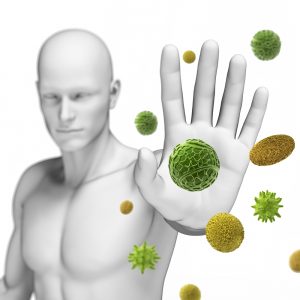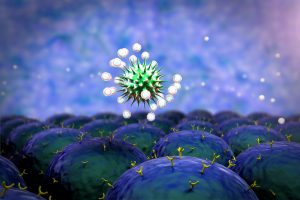Our Immune System; How the Flu Vaccine Works
Posted by Phil Heler, MD on October 25, 2019Our immune system keeps us healthy by fighting infection. Vaccines support this system by imitating infections
This is my last article specifically on colds and flu, this also precedes me taking a one-week break at half term too no less! In the last 12 months, including this piece, I have written six articles on flu and colds characterising each of them separately, explaining why they are seasonal, how they spread and why the flu vaccine is a good idea – but there is one thing that is missing! What allows us to recover?
All organisms, including us, are connected in a complex web of relationships. Although many of these relationships are benign (not all are) everything alive devotes significant resources to identifying and neutralising threats.
From bacteria through to primates, the presence of an effective immune system has gone hand in hand with evolutionary success. It is our immune system that keeps us healthy as we drift through the sea of threats from different pathogens during our lifetimes.
Our Immune System Comprise White blood cells known as Leukocytes
Our immune system is spread throughout our body and involves many types of cells, organs, proteins, and tissues. Crucially, it can distinguish our own tissue from foreign tissue — self from non-self. The immune system comprises white blood cells (known as leukocytes) which, if within normal blood range, exist at between 4,500 and 11,000 per cubic millimetre of blood (or mm3).
Fluctuations occur during the day; lower values are obtained during rest and higher values during exercise. Intense physical exertion may cause the count to exceed 20,000 per cubic millimetre. Most of the leukocytes are outside our vascular circulation and reside in our lymphatic vessels that parallel the veins and arteries. The few that are in our bloodstream are typically in transit from one site to another or on patrol and looking for pathogens.
One Type of Leukocyte is a Phagocyte
Leukocytes are stored in different places in the body, these include the thymus, spleen, bone marrow and lymph nodes. This vast network is constantly on the lookout for invaders, and once an enemy is spotted, a complex attack is mounted. When they find a target, they begin to multiply and send signals out to other cell types to do the same.
There are two types of leukocytes called phagocytes and lymphocytes. Phagocytes (comprising four cell types) are generally the first on the scene in tackling infections. Early in an immune response two of these phagocytic cell types, macrophages and neutrophils, arrive at the site of an environmental breach (such as an insect bite or laceration). Both cell types secrete highly destructive substances such as powerful enzymes and reactive chemicals that kill and digest proteins.
They engulf and digest what they have damaged, a process called phagocytosis (hence the term phagocyte). Macrophages are formed through differentiation of cells called monocytes, one of the major groups of white blood cells of the immune system. When there is tissue damage or infection, the monocytes leave the blood stream and enter the affected tissue or organ and undergo a series of changes to become macrophages. These macrophages can modify themselves to form different structures in order to fight various different microbes and invaders. In this way, macrophages provide a first line of defence in protecting the host from infection. Macrophages can survive for months at a time.
The macrophages’ partner in crime is a neutrophil. The bone marrow of a normal adult produces about 100 billion neutrophils daily. It takes about one week to form a mature neutrophil from a precursor cell in the marrow; yet, once in the blood, the mature cells live only for several hours.
To guard against rapid depletion of the short-lived neutrophils (for example, during infection), the bone marrow holds a large store of them in reserve to be recruited in response to inflammation or infection. Within the body, the neutrophils migrate and target areas of infection or tissue injury. The force of attraction that determines the direction in which neutrophils will travel is attributed to chemical messengers liberated at sites of tissue damage (this is called chemotaxis). Of the 100 billion neutrophils circulating outside the bone marrow, half are in the tissues and half are in the blood vessels.
The Other Type of Leukocyte is a Lymphocyte
Infections that are not destroyed by this combined attack of neutrophils and macrophages also attract the attention of lymphocytes. These cells embody the functions of adaptation and memory, allowing the immune system to make increasingly specific responses and to remember individual types of infection, so that subsequent reinfection is met with a faster and more vigorous counterattack.
They help the body remember previous invaders and recognise them if they reoccur. In human adults’ lymphocytes make up roughly 20-40 % of the total number of leukocytes. They are concentrated in central lymphoid organs and tissues, such as the spleen, tonsils and lymph nodes. Lymphocytes begin their life in our bone marrow. Some stay in the marrow and develop into B lymphocytes (B cells), others will head to the thymus and become T lymphocytes (or T cells).
These two cell types have different roles. B lymphocytes produce antibodies that lock onto an antigen and this helps alert the T lymphocytes. T lymphocytes destroy compromised cells in the body and help alert other leukocytes.
How does the Immune immune System recognise if our own cells are infected by a Virus?
The one problem with all this, is what happens when a virus (such as a cough or a cold) infects a person (or host) and invades cells in order to survive and replicate. Essentially this threat is invisible inside a cell. Once inside, leukocytes cannot ‘see’ the virus and therefore do not know that the host cell is infected. To overcome this, cells employ an amazing system that allows it to demonstrate that it has become infected.
This is the really clever bit. They use molecules called master histocompatibility complex proteins (or MHC) on their cell surfaces that act as a flag or signal that all is not well. The MHC proteins will comprise tiny pieces of protein from inside the cell that, if the cell is infected with a virus, will also include fragments of proteins made by the virus. T lymphocytes that are in circulation looks for cells that are infected with viruses and will subsequently kill them with toxic mediators. T lymphocytes have specialised proteins on their surface that help them to recognise virally infected cells.
These proteins are called T cell receptors (TCRs). Each T lymphocyte cell has a TCR that can specifically recognise each different protein that is demonstrated on the MHC molecule on a cell surface. If the T lymphocyte receptor detects a protein fragment from a virus, it immediately releases cytotoxic factors to kill the infected cell and, therefore, prevent survival of the invading virus.
How does the Flu Vaccine Work?
A flu vaccine helps develop immunity by imitating an infection. A vaccine essentially causes the immune system to produce T-lymphocytes and once the imitation infection goes away, the body is left with a supply of “memory” T-lymphocytes, as well as B-lymphocytes that will remember how to fight that disease in the future. However, it typically takes a few weeks for the body to produce T-lymphocytes and B-lymphocytes after vaccination.
Therefore, it is possible that a person infected with a disease just before or just after vaccination could develop symptoms and get a disease, because the vaccine has not had enough time to provide protection.
Vaccines don’t just work on an individual level; they protect entire populations. Once enough people are immunised, opportunities for an outbreak of disease become so low even people who aren’t immunised benefit.
Essentially, a bacteria or virus simply won’t have enough eligible hosts to establish a foothold and will eventually die out entirely. This phenomenon is called ‘herd immunity”, and it has allowed once-devastating diseases to be eliminated entirely, without needing to vaccinate every individual.
However, if too many people forgo vaccinations, herd immunity can break down, opening the population to the risk of outbreaks. That is why many officials and doctors consider widespread immunisation a public health imperative and blame recent disease outbreaks on a lack of vaccination.
For example, in 1997, prominent medical journal The Lancet published research claiming to have found a link between the measles vaccine and autism. As a result, in following years the parents of over a million British children decided not to vaccinate their kids. The research has since been thoroughly discredited, but the number of measles cases has skyrocketed, from just several dozen a year in 1997 to over 2,000 cases in 2011.

